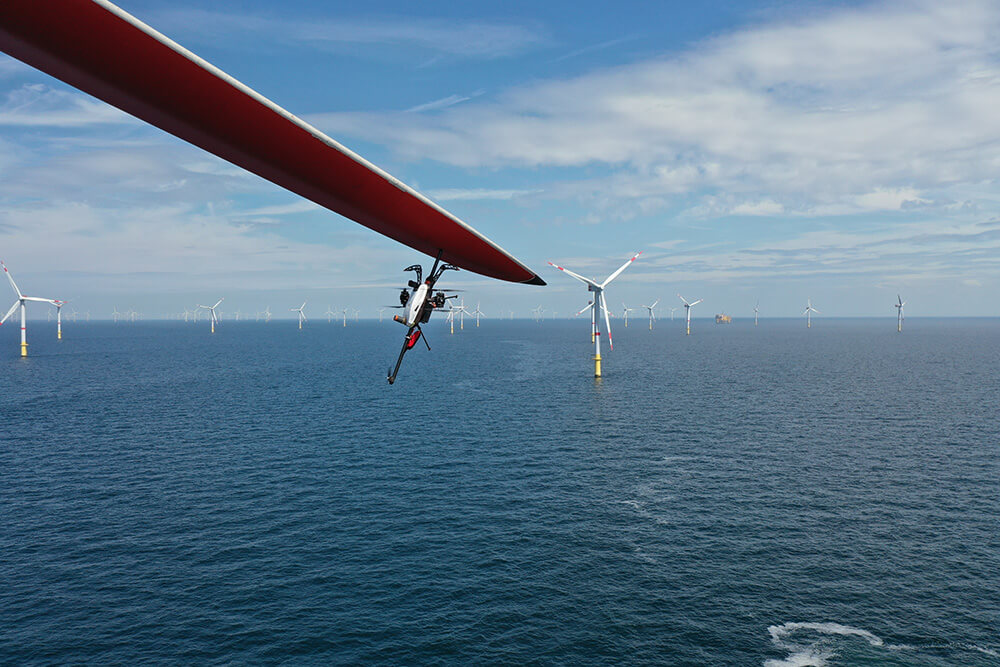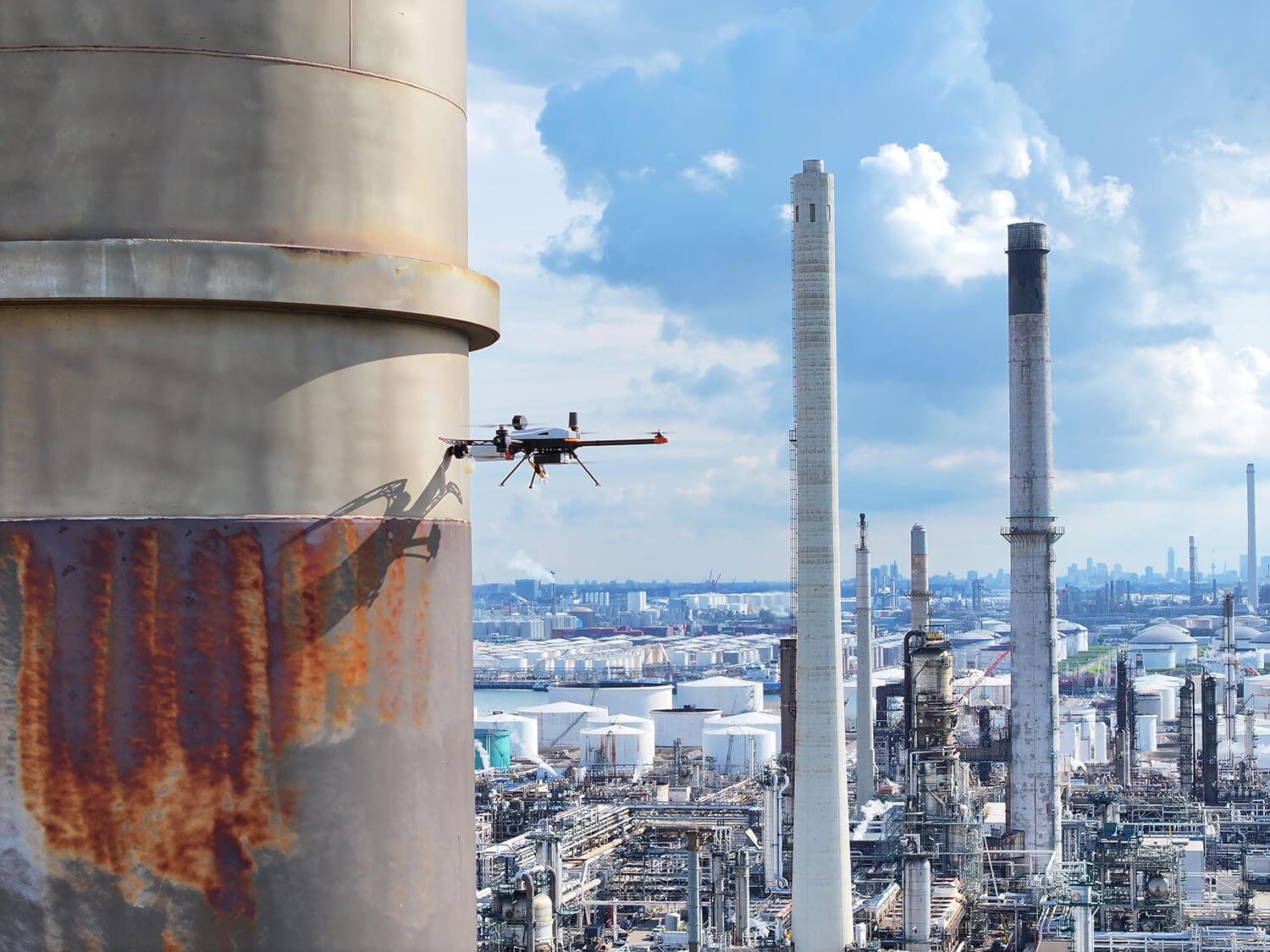The use of uncrewed aircraft systems (UAS) for non-destructive testing (NDT) holds great promise for industrial inspections, particularly in the energy sector. Just ask partners Laurent Zimmerli, VP Customer Experience at Voliro, creators of a unique omnidirectional UA, the Voliro T, and Courtland Penk, President and Drone Inspection Subject Matter Expert (SME) at Osprey Integrity, a multi-industry UAS services company. In this article, the two discuss traditional methods of NDT inspection, a novel UAS technology created to enhance these inspections and a real world case study to illustrate how aerial NDT inspections have already transformed asset management and uptime for energy customers.
The Evolution of NDT
NDT has long been a cornerstone of asset integrity management. Drawing from his extensive background in commercial aviation and industrial inspections, Penk explained, “Non-destructive testing is essentially a noninvasive way of determining the integrity of a structure.” He continued, “NDT methods include ultrasonic testing, electromagnetic testing, radiography and others all aimed to help engineers assess an asset’s fitness for continued service.”
Traditionally, NDT inspections on tall structures or complex industrial assets required scaffolding, elevation platforms or rope access. These methods, while effective, often prove time-consuming, expensive and introduce significant safety risks. Both Penk and Zimmerli saw the potential of UAS to change the game in these inspections.
“We knew that using UAS for NDT inspections would stand to offer a safer, faster and more comprehensive approach, in many hard to access locations” Zimmerli explained. “This could enable companies to detect and address potential issues early to extend asset lifespans and improve overall operational reliability.”
But attempting to combine UAS with NDT instruments presented significant challenges. One primary hurdle involved maintaining consistent contact and force between the NDT instrument and the surface being inspected, all while keeping the UA stable. Voliro’s journey started with a research project in 2016 to accomplish this feat.
“About eight years ago,” Zimmerli said, “we had this funny idea to transform asset management in the energy sector by combining advanced robotics with NDT technologies. In the early days, that involved quite a lot of drone crashes in the lab.”
Another challenge included having to miniaturize sensors for applications such as ultrasonic testing, eddy current analysis and thermography, to use them with UAS.
Ultimately, the design team successfully created a distinctive drone design, the Voliro T, which can exert a consistent amount of force in any direction while ensuring balance and control. Some of the initial team researchers founded Voliro in 2019.
“We saw early adoption of our technology in 2020 and 2021,” Zimmerli noted. “In 2022, we reached general availability, which marked a significant milestone in aerial NDT inspections.”
An Innovative Approach

The unique Voliro T design features a tiltable rotor configuration that provides six degrees of freedom. This allows the UA to approach and interact with surfaces from any angle. This omnidirectional mobility enables it to maintain stability while applying a constant force of up to 6.7 pounds against vertical, angled or even inverted surfaces. This crucial contact capability allows it to perform consistent NDT measurements of the asset being inspected.
In terms of flight performance, the UA offers a flight time of 10-15 minutes, sufficient for most inspections. Of note, the Voliro T can carry payloads of up to 2.2 pounds (1 kg) to accommodate a variety of specialized sensors and probes for different inspection tasks.
The UA’s typical sensor suite includes two 4K cameras, one for piloting and another for inspection, which provides high-quality visual data. It also features a depth camera, six LiDAR distance sensors,and six vision-based velocity sensors to ensure precise navigation and obstacle avoidance. These capabilities, combined with its RTK GPS system, enable it to operate safely and accurately even in GPS-denied environments. It can also plug-and-play with a wide array of interchangeable payloads to perform multiple types of inspection.
This innovative approach enables the UA to perform various NDT tasks, such as ultrasonic thickness measurements, electromagnetic acoustic transducer (EMAT) tests and dry film thickness measurements on complex industrial structures such as wind turbines, storage tanks, stacks, ducting, piping and more.
This type of versatility allows energy companies to streamline their inspection processes and reduce the need for multiple specialized tools or repeated site visits. For example, the UA can inspect an entire wind turbine’s lightning protection system in a single rotor stop in less than 40 minutes. This task typically requires multiple stops and significantly more time. This capability saves while minimizing turbine downtime. All of this directly impacts the operational efficiency of wind farms.
Real-World Impacts
To illustrate the practical benefits of aerial NDT inspections, Penk shared a compelling real-world case study from the oil sands industry in northern Alberta. The inspection involved a large hopper used in oil sands extraction and processing.
Traditional inspection methods for this type of bin would have required scaffolding or rope access, both of which raise significant risks in an already hazardous environment.
The challenge, according to Penk, was to inspect this critical asset without disrupting operations or compromising safety. He explained, “There is a big hopper. It’s a big collection device that’s used in northern Alberta as part of the oil sands extraction and processing process. It’s full of ore most of the time. They only have one of these at site. So if it goes down, production is also affected for a period of time.”
For this reason, the asset owner gave Penk’s team a narrow window of opportunity. “When they approached us for this,” he said, “they only gave us an hour to accomplish the task.”
The UA technology exceeded expectations. Penk successfully performed a comprehensive inspection in just 40 minutes of operational time, with remarkable results.
“We did a line of thickness measurements of each one of the surfaces,” Penk said. “We were able to determine that for them to get another five years of runtime, they actually had to replace only about 40% of the tiles, not 100% which they had initially assumed.”
For the client, this UA-NDT approach translated into significant cost savings. For the inspection itself, Penk emphasized, “The asset owner didn’t have to isolate this piece of equipment. The facility remained operational the entire time we came away with the results.”
This method also offered unique insights into asset integrity without causing any damage to the structure itself. The data collected also provided actionable intelligence which directly led to a 60% reduction in replacement scope. “The savings achieved in materials and reduced facility downtime were substantial,” said Penk.
A New Era Has Begun
The ability to perform inspections without shutting down operations or putting personnel at risk represents a paradigm shift in asset management and has ushered in a new era of asset monitoring for the energy industry. Both Zimmerli and Penk underscored the dual benefits of aerial NDT inspections in terms of enhanced safety and improved efficiency.
Zimmerli noted, “We’re reducing the need to expose people at height, while increasing the consistency of the data collected dramatically.” He continued, “We’re not just providing eyes in the sky, but also robotic hands, if you will, on the surface. This combination allows for a comprehensive assessment of asset integrity.”
Penk echoed this sentiment. “By combining aerial surveillance with ground-level NDT, we’re able to identify potential issues from multiple perspectives,” he said. “The ability to apply consistent force, regardless of the drone’s orientation, opens up new possibilities for inspecting complex structures. It leads to more thorough and timely maintenance decisions. It’s a game-changer for the industry.”
This multifaceted approach to inspections has significant implications for asset uptime. By identifying issues early through aerial surveys and then confirming them with contact-based NDT, asset owners can address problems before they lead to unplanned downtime.
The advent of aerial NDT inspections, as exemplified by Voliro’s technology and Osprey Integrity’s implementation, is undoubtedly reshaping how energy companies approach asset maintenance and integrity management. Combining the versatility of drones with the precision of NDT instruments and expert piloting services, enable safer, more efficient and more comprehensive inspections of critical infrastructure across the energy sector.

